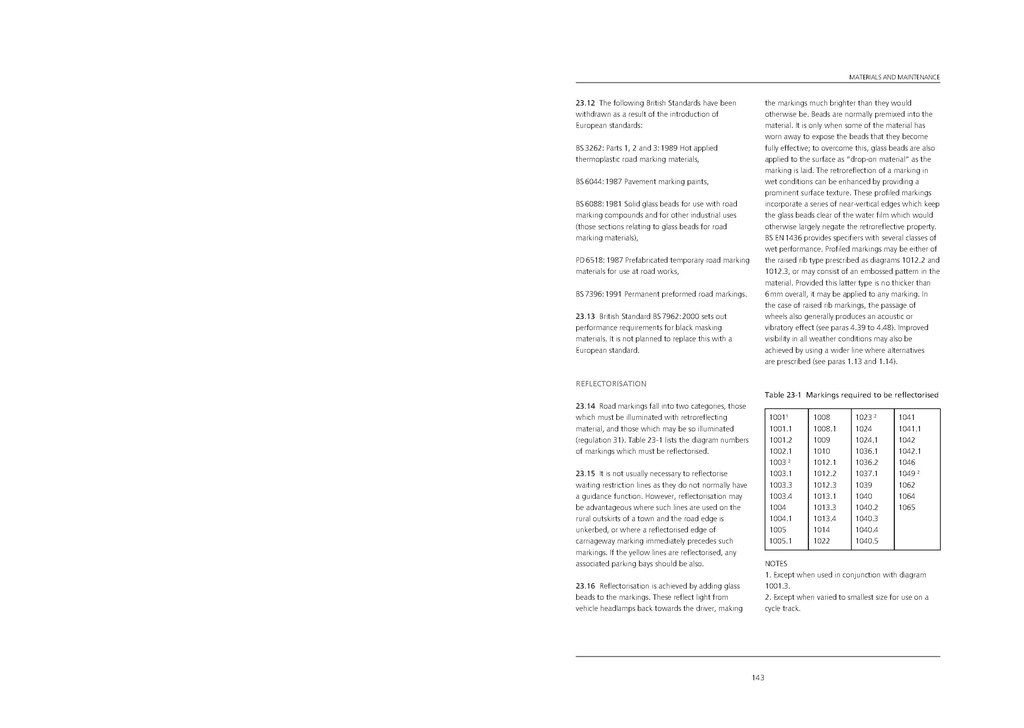23.12 The following British Standards have been withdrawn as a result of the introduction of European standards:
BS 3262: Parts 1, 2 and 3: 1989 Hot applied thermoplastic road marking materials,
BS 6044: 1987 Pavement marking paints,
BS 6088: 1981 Solid glass beads for use with road marking compounds and for other industrial uses (those sections relating to glass beads for road marking materials),
PD 6518: 1987 Prefabricated temporary road marking materials for use at road works,
BS 7396: 1991 Permanent preformed road markings.
23.13 British Standard BS 7962: 2000 sets out performance requirements for black masking materials. It is not planned to replace this with a European standard.
REFLECTORISATION
23.14 Road markings fall into two categories, those which must be illuminated with retroreflecting material, and those which may be so illuminated (regulation 31). Table [[#table23.1|23-1 lists the diagram numbers of markings which must be reflectorised.
23.15 It is not usually necessary to reflectorise waiting restriction lines as they do not normally have a guidance function. However, reflectorisation may be advantageous where such lines are used on the rural outskirts of a town and the road edge is unkerbed, or where a reflectorised edge of carriageway marking immediately precedes such markings. If the yellow lines are reflectorised, any associated parking bays should be also.
23.16 Reflectorisation is achieved by adding glass beads to the markings. These reflect light from vehicle headlamps back towards the driver, making the markings much brighter than they would otherwise be. Beads are normally premixed into the material. It is only when some of the material has worn away to expose the beads that they become fully effective; to overcome this, glass beads are also applied to the surface as "drop-on material" as the marking is laid. The retroreflection of a marking in wet conditions can be enhanced by providing a prominent surface texture. These profiled markings incorporate a series of near-vertical edges which keep the glass beads clear of the water film which would otherwise largely negate the retroreflective property. BS EN 1436 provides specifiers with several classes of wet performance. Profiled markings may be either of the raised rib type prescribed as diagrams 1012.2 and 1012.3, or may consist of an embossed pattern in the material. Provided this latter type is no thicker than 6 mm overall, it may be applied to any marking. In the case of raised rib markings, the passage of wheels also generally produces an acoustic or vibratory effect (see paras 4.39 to 4.48). Improved visibility in all weather conditions may also be achieved by using a wider line where alternatives are prescribed (see paras 1.13 and 1.14).
| 10011 | 1008 | 10232 | 1041 |
| 1001.1 | 1008.1 | 1024 | 1041.1 |
| 1001.2 | 1009 | 1024.1 | 1042 |
| 1002.1 | 1010 | 1036.1 | 1042.1 |
| 10032 | 1012.1 | 1036.2 | 1046 |
| 1003.1 | 1012.2 | 1037.1 | 10492 |
| 1003.3 | 1012.3 | 1039 | 1062 |
| 1003.4 | 1013.1 | 1040 | 1064 |
| 1004 | 1013.3 | 1040.2 | 1065 |
| 1004.1 | 1013.4 | 1040.3 | |
| 1005 | 1014 | 1040.4 | |
| 1005.1 | 1022 | 1040.5 |
NOTES:
- Except when used in conjunction with diagram 1001.3.
- Except when varied to smallest size for use on a cycle track.
143
